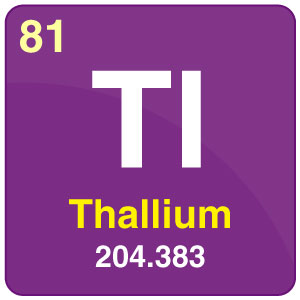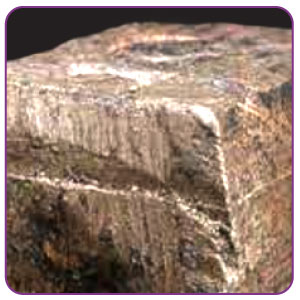Thallium

| Symbol | Tl |
| Atomic Number | 81 |
| Atomic Mass | 204.383 g.mol −1 |
| Discovered by | Sir William Crookes in 1861 |

Table of Contents
- Chemical Properties of Thallium
- What is Thallium?
- Uses of Thallium
- Properties of Thallium
- Certain Facts About Thallium
- Frequently Asked Questions – FAQs
Chemical Properties of Thallium
| Group | Boron | Melting point | 304 °C |
| Period | 6 | Boiling point | 1473 °C |
| Block | 13 | Density (g cm−3) | 11.71 g.cm−3 at 20°C |
| Atomic number | 81 | Relative atomic mass | 204.383 g.mol -1 |
| State at 20°C | Solid | Key isotopes | 205Tl |
| Electron configuration | [Xe] 4f14 5d10 6s2 6p1 | CAS number | 7440-28-0 |
| ChemSpider ID | 4514293 | ChemSpider is a free chemical structure database | |
What is Thallium?
- Thallium with an atomic number of 81 is found in the periodic table with the symbol Tl.
- Thallium is not freely found in nature. It is a soft grey post-transition metal. It resembles tin when isolated but when exposed to air it may discolour.
- There are around eighty-one electrons present in the atom of thallium with an electronic configuration of [Xe] 4f14 5d10 6s2 6p1.
- This element can be generated artificially. It can be obtained by smelting lead and zinc. It is generally obtained as a by-product in the production of sulphuric acid.
Uses of Thallium
- In ancient times it was used as a rat poison and as an ant killer.
- Thallium compounds are used in the manufacture of glasses.
- It is used in photocells.
- It is used in the production of infrared optics.
Properties of Thallium
- Thallium melts easily.
- Thallium salts that are soluble are generally toxic. They are merely tasteless.
- It oxidises at +3 and +1 oxidation states, forming ionic salts.
- There are several thallium compounds wherein thallium(III) resembles the aluminium (III) compounds.
Certain Facts About Thallium
- It was named after the Greek word thallus which means twig.
- Thallium is suspected to be carcinogenic. Hence direct contact should be avoided with the skin.
Frequently Asked Questions – FAQs
Q1
What is thallium in chemistry?
Thallium (Tl) is a chemical element or a metal of the main Group 13 (IIIa, or boron group) of the periodic table. It is poisonous. Like lead, thallium is also a soft and low-melting element. Freshly cut thallium has a metallic lustre that dulls to bluish-grey upon exposure to air.
Q2
Is thallium soluble in water?
Thallium does not dissolve in water.
Q3
What colour is thallium?
It is a soft and silvery-white metal that tarnishes easily.
Q4
Does thallium react with acid?
Thallium dissolves only slowly in sulphuric acid, H2SO4, or hydrochloric acid, HCl, because the poisonous thallium(I) salts produced are not very soluble.


Comments